Xin Q. Diesel Engine System Design
Подождите немного. Документ загружается.

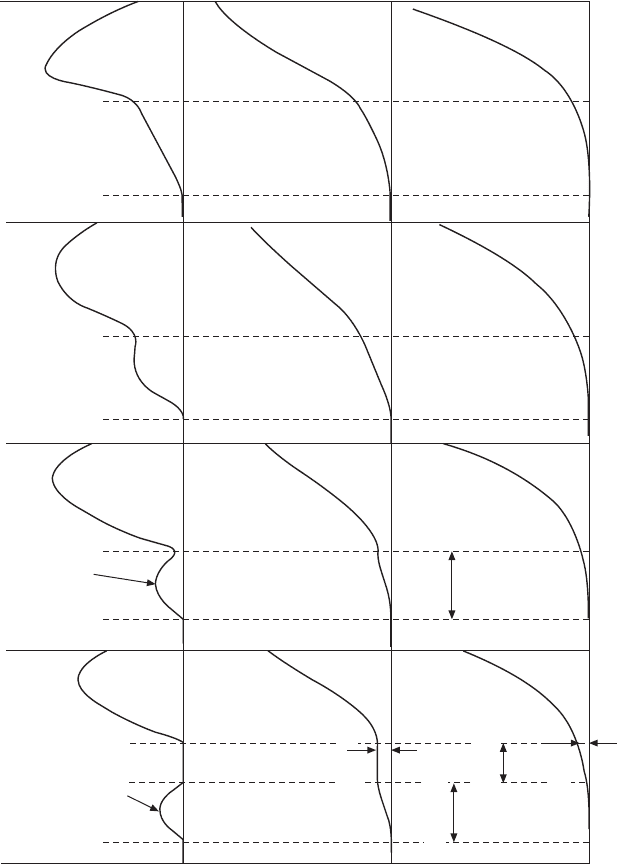
© Woodhead Publishing Limited, 2011
Constant-
velocity ramp
Variable-acceleration
ramp
Constant-
acceleration ramp
Constant-jerk
ramp
Cam angle Cam angle Cam angle Cam angle
Cam accelerationCam velocityCam lift
1
2 3 1 3
a
CAM,OpenRamp
v
CAM,OpenRamp
l
CAM,OpenRamp
a
peak
CAM,OpenRamp
Df
CAM, 1-3
Df
CAM, 2-3
Df
CAM, 1-2
9.20 Illustration of different types of cam opening ramps.
Diesel-Xin-09.indd 570 5/5/11 11:59:02 AM
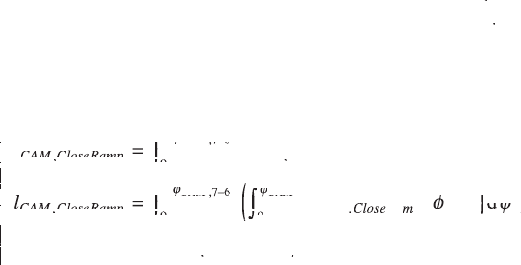
571Advanced diesel valvetrain system design
© Woodhead Publishing Limited, 2011
In equation 9.14, the opening ramp height, l
CAM,OpenRamp
, and the opening ramp
velocity, v
CAM,OpenRamp
, are prescribed known inputs. The cam opening ramp
acceleration, a
CAM,OpenRamp
, is a prescribed polynomial (e.g., a second-order
polynomial) as a function of cam angle with certain assumed acceleration
height. The two unknowns in equation 9.14, Df
CAM,1–2
and Df
CAM,2–3
, need to
be solved iteratively. For the variable-acceleration ramp (Fig. 9.20), the two
unknowns in the formulation of ramp blending are Df
CAM,1–3
and
a
CA
MO
pe
MOpeMO
nR
am
p
ampam
peak
be solved iteratively. For the variable-acceleration ramp (Fig. 9.20), the two
peak
be solved iteratively. For the variable-acceleration ramp (Fig. 9.20), the two
,
MO,MO
.
The ramp blending is also required in the dynamic cam design.
The mathematical formulation for connecting the constant-velocity closing
ramp with the main cam event is given similarly as follows (Fig. 9.19):
va
CA
va
CA
va
MC
va
MC
va
lose
va
lose
va
Ramp
va
Ramp
va
CA
MC
lose
Ramp
CA
M
CA
M
,,
CA,,CA
MC,,MC
,,
MC,,MC
lose,,lose
Ramp,,Ramp
va =va
d
va dva
CA
d
CA
MC
d
MC
lose
d
lose
Ramp
d
Ramp
d
va dva
CA
d
CA
M
d
M
,7–6
d
,7–6
d
0
,,
0
,,
D
Ú
va
Ú
va
Ú
,,
Ú
,,
d
Ú
d
va dva
Ú
va dva
0
Ú
0
,,
0
,,
Ú
,,
0
,,
f
CA
f
CA
d
f
d
f
la
llal
CA
la
CA
la
MC
la
MC
la
lose
la
lose
la
Ramp
la
Ramp
la
Ramp
,,
MC,,MC
lose,,lose
Ramp,,Ramp
la =la
00
D
ÚÚ
la
ÚÚ
la
ÚÚ
,,
ÚÚ
,,
la
,7–6
la
ÚÚ
la
,7–6
la
00
ÚÚ
00
,,
00
,,
ÚÚ
,,
00
,,
D
ÚÚ
D
ff
ÚÚ
ff
ÚÚ
la
ÚÚ
la
ff
la
ÚÚ
la
CA
ÚÚ
CA
ff
CA
ÚÚ
CA
la
CA
la
ÚÚ
la
CA
la
ff
la
CA
la
ÚÚ
la
CA
la
MC
ÚÚ
MC
ff
MC
ÚÚ
MC
la
MC
la
ÚÚ
la
MC
la
ff
la
MC
la
ÚÚ
la
MC
la
MC
ÚÚ
MC
ff
MC
ÚÚ
MC
la
MC
la
ÚÚ
la
MC
la
ff
la
MC
la
ÚÚ
la
MC
la
,7–6
ÚÚ
,7–6
ff
,7–6
ÚÚ
,7–6
la
,7–6
la
ÚÚ
la
,7–6
la
ff
la
,7–6
la
ÚÚ
la
,7–6
la
MC,7–6MC
ÚÚ
MC,7–6MC
ff
MC,7–6MC
ÚÚ
MC,7–6MC
la
MC
la
,7–6
la
MC
la
ÚÚ
la
MC
la
,7–6
la
MC
la
ff
la
MC
la
,7–6
la
MC
la
ÚÚ
la
MC
la
,7–6
la
MC
la
MC
AM
MCAMMC
CA
MC
lose
Ramp
CA
M
v
dd
+
,,
MC,,MC
lose,,lose
Ramp,,Ramp
CA,,CA
M,,M
6–5
ff
MC
ff
MC
dd
ff
dd
MC
dd
MC
ff
MC
dd
MC
f
,,
f
,,
()
la
()
la
CA
()
CA
MR
()
MR
a
()
a
MC
()
MC
la
MC
la
()
la
MC
la
AM
()
AM
la
AM
la
()
la
AM
la
MCAMMC
()
MCAMMC
la
MC
la
AM
la
MC
la
()
la
MC
la
AM
la
MC
la
,,
()
,,
CA,,CA
()
CA,,CA
MR,,MR
()
MR,,MR
00
()
00
,,
00
,,
()
,,
00
,,
ÚÚ
()
ÚÚ
la
ÚÚ
la
()
la
ÚÚ
la
00
ÚÚ
00
()
00
ÚÚ
00
,,
00
,,
ÚÚ
,,
00
,,
()
,,
00
,,
ÚÚ
,,
00
,,
ff
()
ff
la
ff
la
()
la
ff
la
MC
ff
MC
()
MC
ff
MC
la
MC
la
ff
la
MC
la
()
la
MC
la
ff
la
MC
la
ÚÚ
ff
ÚÚ
()
ÚÚ
ff
ÚÚ
la
ÚÚ
la
ff
la
ÚÚ
la
()
la
ÚÚ
la
ff
la
ÚÚ
la
MC
ÚÚ
MC
ff
MC
ÚÚ
MC
()
MC
ÚÚ
MC
ff
MC
ÚÚ
MC
la
MC
la
ÚÚ
la
MC
la
ff
la
MC
la
ÚÚ
la
MC
la
()
la
MC
la
ÚÚ
la
MC
la
ff
la
MC
la
ÚÚ
la
MC
la
Clos
()
Clos
MRClosMR
()
MRClosMR
em
()
em
MRemMR
()
MRemMR
aema
()
aema
mp
()
mp
emmpem
()
emmpem
dd
()
dd
ff
()
ff
CA
ff
CA
()
CA
ff
CA
MC
ff
MC
()
MC
ff
MC
dd
ff
dd
()
dd
ff
dd
CA
dd
CA
ff
CA
dd
CA
()
CA
dd
CA
ff
CA
dd
CA
MC
dd
MC
ff
MC
dd
MC
()
MC
dd
MC
ff
MC
dd
MC
D
Ï
Ì
Ô
Ï
Ô
Ï
Ô
Ô
Ô
Ô
Ô
Ì
Ô
Ì
Ô
Ô
Ô
Ó
Ô
Ì
Ô
Ì
ÔÔÔ
Ô
Ô
Ô
Ô
Ô
Ô
Ô
Ô
Ó
Ô
Ó
ÔÔÔ
Ô
ÔÔÔ
9.15
The l
CAM,CloseRamp
and v
CAM,CloseRamp
are the actual cam lift and cam velocity,
respectively, exactly at the end of the main cam closing event where the cam
acceleration is equal to zero. The a
CAM,CloseRamp
is a prescribed polynomial as
a function of cam angle with certain assumed acceleration height. The two
unknowns in 9.15, Df
CAM,7–6
and Df
CAM,6–5
, need to be solved iteratively.
There are generally two methods to generate the cam lift pro le in the
main cam event in the kinematic cam design, namely, analytical solution and
numerical integration. The advantage of the analytical solution is that the
ending points of the main cam events are precisely de ned. The disadvantage
is that the choice of the acceleration pro le is limited to certain pre-de ned
mathematical functions (e.g., sine wave, harmonic wave, polynomial) and
local adjustment is impossible. The numerical integration method is just the
opposite. The coef cients used in the analytical solution that represent the
cam acceleration pro le are solved by using the design constraints or the
boundary conditions described in the previous section. The boundary conditions
are usually set at the end of the valve event and the cam nose. Higher-order
time derivatives (at least to the cam jerk level) are usually required in order
to ensure the continuity and smoothness of the cam acceleration pro le.
The multi-piece polynomial or multi-segment cam design method belongs
to the analytical kinematic cam design method. In this case, more boundary
conditions are required at the end of the multiple segments such as on the
cam anks (Heath, 1988; Keribar, 2000).
In the numerical integration method, it should be noted that simply
integrating any arbitrary cam acceleration pro le without the boundary
conditions usually does not produce an acceptable cam lift pro le for the
Diesel-Xin-09.indd 571 5/5/11 11:59:03 AM
572 Diesel engine system design
© Woodhead Publishing Limited, 2011
following two reasons. First, the target cam ramp height and velocity cannot
be guaranteed by the arbitrary cam acceleration. Secondly, the cam lift,
velocity, and acceleration at the end of the cam event reach zero at different
cam angles due to both the lack of kinematic constraints and the round-off
errors accumulated during the numerical integration. The round-off errors
exist even if a higher-order integration scheme and a small cam angle step
are used (e.g., the fourth-order Runge-Kutta integration with 0.1° cam angle
step). Appropriate cam ramp blending must be used to x the round-off error
problem at the closing ramp. The procedure of the numerical integration
method is summarized in the following steps:
1. Use the target values of cam opening ramp height and cam opening
ramp velocity to establish the opening ramp by solving equation 9.14.
2. Construct a smooth cam acceleration prole for the main cam event.
3. Integrate the cam acceleration with respect to cam angle to obtain cam
velocity, and integrate the cam velocity to obtain the cam lift prole.
4. Adjust the cam acceleration until the target maximum cam lift is achieved,
and match the closing ramp height and velocity at zero cam acceleration
to the target values as closely as possible.
5. Use the actual closing ramp height and velocity to establish the closing
ramp by solving equation 9.15 for acceptable ramp duration. Integrate
the cam acceleration to obtain the cam ramp velocity and lift proles
to the end of the cam closing ramp.
More information on cam ramps can be found in Norton et al. (1999).
9.5 Valve spring design
9.5.1 Analytical design method for valve springs
Valve spring design has equal importance as cam design for engine system
performance. The functions of the valve spring include preventing the valve
from oating off the seat under gas pressure loading and controlling the valve
motion to avoid valvetrain separation. Valve spring design affects cam stress,
valvetrain friction, and spring surge. Engine valve springs are usually open
coil helical compression springs with closed ground ends. Most engines use
constant-rate springs although some engines use variable-rate springs. The
single-spring design is usually sufcient for diesel engines, but sometimes
the double-spring design using a damper spring or an inner spring is required
in order to reduce the severity of valve spring surge. Valve spring design
is a very complex task. It may serve as a good showcase to illustrate the
principles of engine system design for the following three reasons. First, the
analytical spring design method illustrates the link between the component
design parameters and the system design parameters. Secondly, the analytical
spring design method illustrates the mathematical formulations for the same
Diesel-Xin-09.indd 572 5/5/11 11:59:03 AM
573Advanced diesel valvetrain system design
© Woodhead Publishing Limited, 2011
design topic as a deterministic solution or an optimization solution. In the
optimization formulation, explicit objective functions and constraint functions
are used. Note that in most of other areas of engine system design (e.g.,
cycle performance, cam design, and valvetrain dynamics) the optimization
functions are usually the more complex implicit functions. Thirdly, the
analytical spring design method provides an example of using a graphical
design approach to construct parametric sweeping maps to handle the multi-
dimensional design problems that are frequently encountered in diesel engine
system design.
In valve spring design, the input data include the following: (1) the
maximum valve lift; (2) the given installed (tted) spring length; (3) the
required spring preload; and (4) the required spring rate. Note that the spring
preload and spring rate are system-level design parameters and need to satisfy
the requirements of the maximum allowable spring force and cam stress,
exhaust valve sealing, and valvetrain no-follow control. There is a strong
interaction between valve spring design and cam design. If it is difcult to
nd a solution to spring design, the input data have to be revised.
The following parameters are calculated as outputs in valve spring design:
(1) basic or independent spring design parameters (i.e., spring mean diameter,
spring wire coil diameter, the number of active coils); and (2) derived design
parameters (e.g., spring free length, maximum compressed length, solid length,
the free clearance between the coils, the solid clearance at the maximum
compression between the coils, spring natural frequency and surge order, the
maximum spring load, and the maximum spring torsional stress). The basic
spring design parameters determine the spring rate. Spring design is a multi-
dimensional design problem that can be handled by a graphical approach
to examine the parametric sensitivity trend (Fig. 9.21). Some of the output
parameters are subject to certain design constraints. For example, installed
length and spring mean diameter are subject to the constraints of packaging
space. The spring torsional stresses at the maximum spring compression
and at the solid length are subject to the constraints of spring fatigue life/
strength and the maximum allowable stress limit. The constraint of spring
surge protection is applied to the solid clearance and the spring natural
frequency. The spring surge order is the ratio of the spring natural frequency
to the engine operating frequency. In order to assure that the spring will not
surge in operation, the natural frequency of the valve spring should usually
be at least 13 times the operating frequency of the engine, i.e., a surge order
higher than 13th is usually preferred. If the spring natural frequency analysis
shows that the spring is responsive to one of the dominant harmonics of the
cam prole, the tendency of spring surge denitely exists. In this case, a
design revision is required for the cam or the spring. Sometimes variable-
rate springs or nested springs can be used to vary the spring frequency in
order to help alleviate the spring surge problem.
Diesel-Xin-09.indd 573 5/5/11 11:59:03 AM
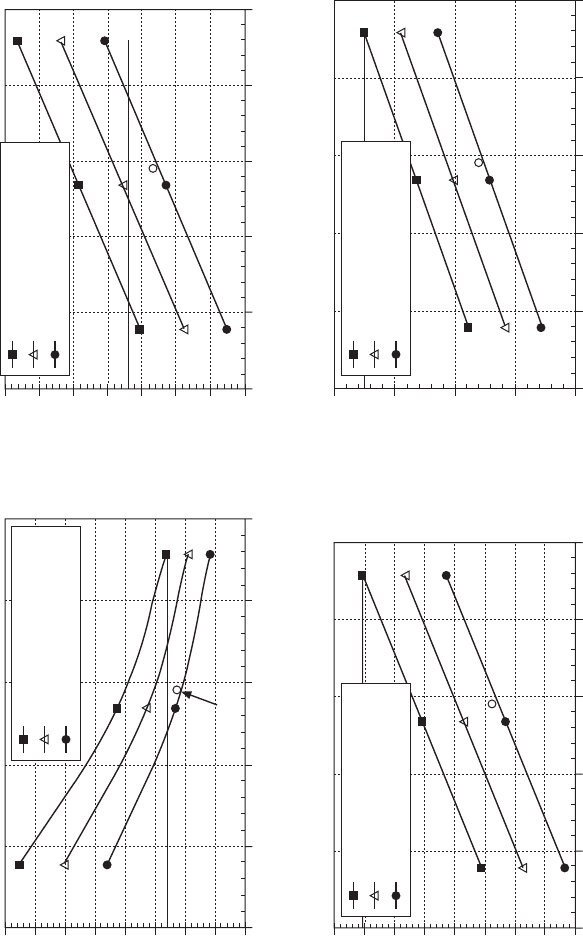
© Woodhead Publishing Limited, 2011
9.21 Analytical engine valve spring design method (intake valve spring).
Engine valve spring design chart, design
constraint: fitted length 1.575”
Engine valve spring design chart, design
constraint: intake valve maximum lift 0.413”
Engine valve spring design chart, design
constraint: intake valve maximum lift 0.413”
Engine valve spring design chart, design constraints: inside
diameter 0.975”, wire diameter 0.156”, fitted length 1.575”
Two-spring preload 184 lb
Two-spring preload 157 lb
Two-spring preload 129 lb
Two-spring preload 184 lb
Two-spring preload 157 lb
Two-spring preload 129 lb
Two-spring preload 184 lb
Two-spring preload 157 lb
Two-spring preload 129 lb
Two-spring preload 184 lb
Two-spring preload 157 lb
Two-spring preload 129 lb
150 200 250 300 350 400
Valve spring rate (two-valve total, lb/inch)
150 200 250 300 350 400
Valve spring rate (two-valve total, lb/inch)
150 200 250 300 350 400
Valve spring rate (two-valve total, lb/inch)
150 200 250 300 350 400
Valve spring rate (two-valve total, lb/inch)
Spring free length (inch)
Stress at maximum valve lift (psi)
Intake valvetrain friction power at
rated full load 2300 rpm (hp)
Valve spring load at maximum
valve lift (two-spring total, lb)
2.6
2.5
2.4
2.3
2.2
2.1
2.0
1.9
1.8
160,000
150,000
140,000
130,000
120,000
110,000
100,000
90,000
4.0
3.5
3.0
2.5
2.0
360
340
320
300
280
260
240
220
200
Baseline spring
Design point of new spring
Diesel-Xin-09.indd 574 5/5/11 11:59:03 AM
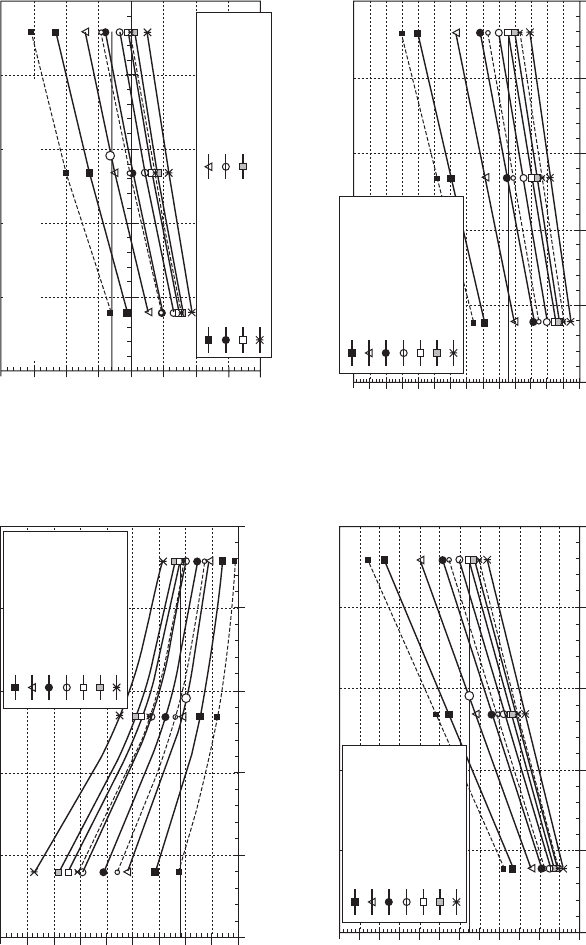
© Woodhead Publishing Limited, 2011
150 200 250 300 350 400
Valve spring rate (two-valve total, lb/inch)
150 200 250 300 350 400
Valve spring rate (two-valve total, lb/inch)
150 200 250 300 350 400
Valve spring rate (two-valve total, lb/inch)
Valve spring rate (two-valve total, lb/inch)
Engine valve spring design chart, design constraints: inside
diameter 0.975” (solid), 1.05” (dotted); fitted length 1.575”
Engine valve spring design chart, design constraints: inside
diameter 0.975” (solid), 1.05” (dotted); fitted length 1.575”
Engine valve spring design chart, design constraints: inside
diameter 0.975” (solid), 1.05” (dotted); fitted length 1.575”
Engine valve spring design chart, design constraints: inside
diameter 0.975” (solid), 1.05” (dotted); fitted length 1.575”
Note: Inactive coil number 1.5 at each
end. (light dot: 1.1; dark dot: 1.3)
Wire diameter 0.148”
Wire diameter 0.156”
Wire diameter 0.162”
Wire diameter 0.167”
Wire diameter 0.170”
Wire diameter 0.172”
Wire diameter 0.177”
Wire diameter 0.148”
Wire diameter 0.156”
Wire diameter 0.162”
Wire diameter 0.167”
Wire diameter 0.170”
Wire diameter 0.172”
Wire diameter 0.177”
Wire diameter 0.148”
Wire diameter 0.156”
Wire diameter 0.162”
Wire diameter 0.167”
Wire diameter 0.170”
Wire diameter 0.172”
Wire diameter 0.177”
Wire diameter 0.148”
Wire diameter 0.162”
Wire diameter 0.170”
Wire diameter 0.177”
Wire diameter 0.156”
Wire diameter 0.167”
Wire diameter 0.172”
Spring active number of coils
Spring natural frequency (Hz)
Stress at max valve lift (psi)
11
10
9
8
7
6
5
4
3
2
750
700
650
600
550
500
450
400
350
300
250
200
150
220,000
210,000
200,000
190,000
180,000
170,000
160,000
150,000
140,000
130,000
120,000
110,000
100,000
90,000
80,000
Solid clearance per coil (inch)
defined as total solid clearance
divided by (N+1)
0.2
0.15
0.1
0.05
0
–0.05
–0.1
–0.15
–0.2
9.21 Continued
150 200 250 300 350 400
Diesel-Xin-09.indd 575 5/18/11 11:27:27 AM
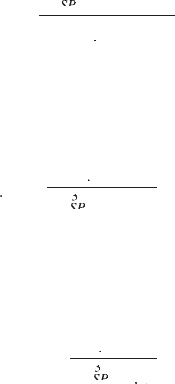
576 Diesel engine system design
© Woodhead Publishing Limited, 2011
The objective of valve spring design optimization is to maximize the
spring natural frequency to minimize spring surge, subject to the following
constraints: (1) the system requirements of spring preload and spring rate;
(2) the maximum allowable spring stress; and (3) appropriate solid clearance
to control spring surge vibration.
For more information on valve spring design and spring dynamics, the
reader is referred to Wang (2007), Turkish (1987), Phlips et al. (1989), Muhr
(1993), Schamel et al. (1993), Lee and Patterson (1997), Takashima et al.
(2005), SAE J1121 (2006) and J1122 (2004).
9.5.2 Deterministic and optimization solutions of spring
design
The valve spring design formulae are summarized as below in order to
illustrate the parametric dependency among the valvetrain parameters. Further
details on the derivations of the formulae can be found in many handbooks
on spring design. The static spring outside diameter is calculated by
d
SP,outer
= d
SP,inner
+ 2d
SC
9.16
where d
SP,in
is the static spring inside diameter, and d
SC
is the spring coil
wire diameter. The static spring mean diameter is de ned as:
d
SP
= 0.5(d
SP,in
+ d
SP,out
) 9.17
The valve spring de ection Dl
SP
at the spring load F
SP
is calculated by
D
l
Fd
n
d
SP
SP
Fd
SP
Fd
SP
Fd
SP
Fd
SC
activ
e
mS
PS
d
PS
d
mSPSmS
C
=
8
3
,
,
mS,mS
4
J
9.18
where n
SC,active
is the number of active coils, and ϑJ
m,SP
is the torsional modulus
of rigidity of the spring. Since the spring rate K
s,SP
= F
SP
/Dl
SP
, the spring
rate can be expressed as:
K
d
dn
sS
P
sSPsS
mS
PS
d
PS
d
mSPSmS
C
SP
dn
SP
dn
SC
activ
e
,
sS,sS
,
mS,mS
4
3
dn
3
dn
,
=
8
J
9.19
where d
SP
, d
SC
and n
SC,active
have selected design values. If K
s,SP
is a known
input requirement, the number of active coils can be calculated by re-arranging
equation 9.19 as:
n
d
dK
SC
activ
e
mS
PS
d
PS
d
mSPSmS
C
SP
dK
SP
dK
sS
P
sSPsS
,
,
mS,mS
4
3
dK
3
dK
,
sS,sS
=
8
J
9.20
Diesel-Xin-09.indd 576 5/5/11 11:59:04 AM
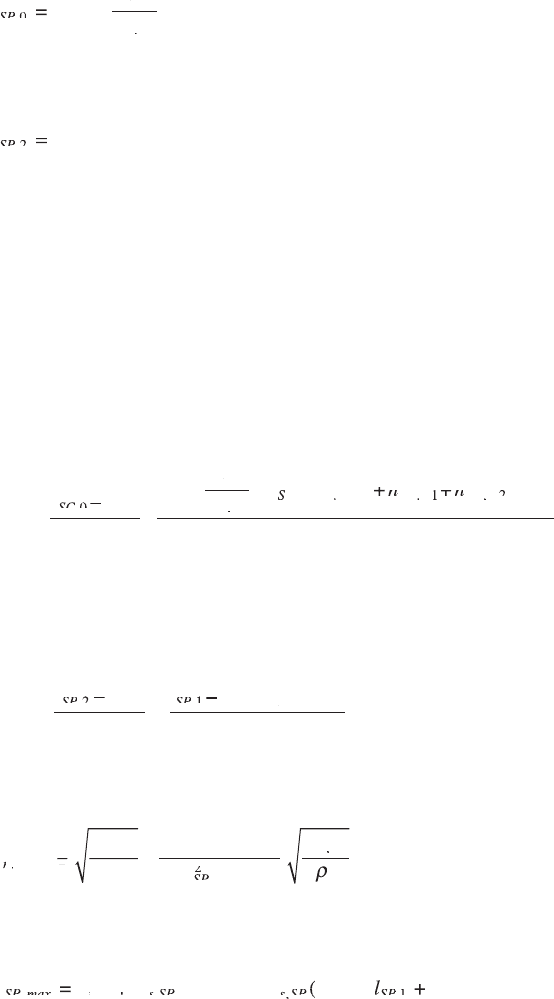
577Advanced diesel valvetrain system design
© Woodhead Publishing Limited, 2011
The spring’s free length at zero load can be calculated with the given spring
preload F
pre
and the installed spring length l
SP,1
as follows:
ll
F
K
SP
ll
SP
ll
SP
pr
F
pr
F
e
sS
P
sSPsS
,0
ll
,0
ll
,1
,
sS,sS
ll =ll
ll ll
SP
SP
,1
,1
+
9.21
The maximum compressed spring length at the maximum valve lift is given
by
ll
l
SP
ll
SP
ll
SP
VAL
,m
ax
,2
ll
,2
ll
,1
ll = ll
–
9.22
The spring’s solid length can be calculated by:
l
SP,3
= d
SC
(n
SC,active
+ n
SC,ia1
+ n
SC,ia2
– 0.5) 9.23
where n
SC,ia1
and n
SC,ia2
are the number of inactive coils at the two ends of
the spring. Note that the solid length needs to be shorter than the maximum
compressed spring length. At least one inactive coil is required for each end
of the spring. Using more inactive coils at each end (e.g., 1.25) provides
a more gradual change from the inactive to the active (working) coils for
highly stressed springs. The free clearance between the coils at the free
length is largely affected by the installed spring length. The free clearance
is given by:
c
ll
n
l
F
K
d
SP
SC
ll
SC
ll
SC
activ
e
SP
pr
F
pr
F
e
sS
P
sSPsS
,0
,0
ll
,0
ll
,3
,
,1
,
sS,sS
=
ll–ll
+1
=
+–
+–
K
+–
K
pr
+–
pr
SP
SC
SSCS
d
S
d
SC
d
S
d
SC
eS
Ci
aS
Ci
a
SC
activ
e
nn
eS
nn
eS
n
(+
SC
(+
SC
activ
(+
activ
eS
(+
eS
nn(+nn
SC
nn
SC
(+
SC
nn
SC
activ
nn
activ
(+
activ
nn
activ
eS
nn
eS
(+
eS
nn
eS
+–
Ci
+–
Ci
a
+–
a
n+–n
0.5)
+1
,,
activ,,activ
eS,,eS
Ci,,Ci
(+
,,
(+
activ
(+
activ,,activ
(+
activ
eS
(+
eS,,eS
(+
eS
1,
aS1,aS
Ci1,Ci
aS
n
aS1,aS
n
aS
+–
1,
+–
aS
+–
aS1,aS
+–
aS
Ci
+–
Ci1,Ci
+–
Ci
n+–n
1,
n+–n
aS
n
aS
+–
aS
n
aS1,aS
n
aS
+–
aS
n
aS
2
+–
2
+–
,
9.24
The free clearance should not be excessively large in order to minimize
the height of the cylinder head. The solid clearance per active coil at the
maximum valve lift is given by:
c
ll
n
ll
SC
SP
ll
SP
ll
SC
activ
e
SP
ll
SP
ll
VAL
ma
x
maxma
,2
,2
ll
,2
ll
,3
,
,1
ll
,1
ll
,
=
ll–ll
+1
=
ll– ll
SP
–
+1
,3
,
l
n
SP
SC
activ
e
9.25
The spring’s rst natural frequency is calculated for the distributed mass of
the spring as follows:
f
K
m
d
dn
nS
f
nS
f
P
nSPnS
SC
d
SC
d
SP
dn
SP
dn
SC
activ
e
mS
P
mSPmS
,
nS,nS
,
2
dn
2
dn
,
,
mS,mS
=
=
2
2
1
2
2
SS
,SS,
P
SSPSS
SP
p
dn
p
dn
J
rrr
SP
9.26
where m
SP
is spring mass and r
SP
is the density of the spring material. The
maximum spring load at the maximum valve lift is calculated as follows:
FF
Kl
Kl
SP
FF
SP
FF
,m
FF
,m
FF
ax
FF
ax
FF
pr
FF
pr
FF
es
Kl
es
Kl
SP
Kl
SP
Kl
VAL
,m
ax
sS
PS
Kl
PS
Kl
sSPSsS
P
PSPPS
FF =FF
FF FF
pr
pr
FF
pr
FF FF
pr
FF
es
es
+
es
+
es
=
(
Kl (Kl
sS
(
sS
Kl
sS
Kl (Kl
sS
Kl
PS
(
PS
Kl
PS
Kl (Kl
PS
Kl
sSPSsS
(
sSPSsS
Kl
sS
Kl
PS
Kl
sS
Kl (Kl
sS
Kl
PS
Kl
sS
Kl
–
,,
SP,,SP
VAL,,VAL
,m,,,m
ax,,ax
sS,,sS
(
,,
(
sS
(
sS,,sS
(
sS
,0
ll
llll
SP
ll
SP
ll
VAL
ma
x
maxma
,1
ll
,1
ll
,
ll +ll
)
ll )ll
VAL
)
VAL
ma
)
ma
x
)
x
maxma
)
maxma
,
)
,
9.27
Diesel-Xin-09.indd 577 5/5/11 11:59:06 AM
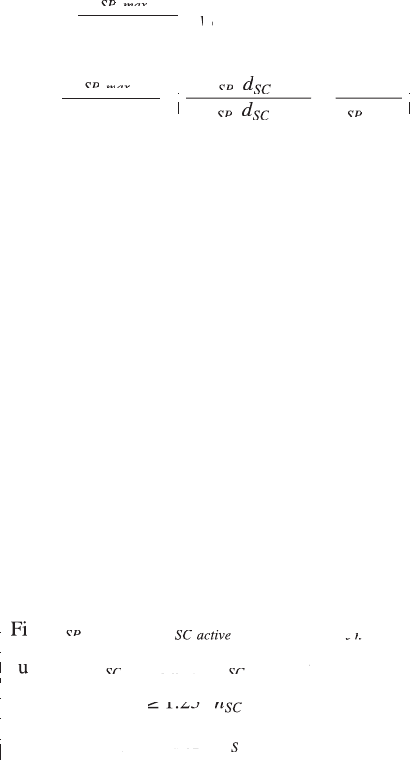
578 Diesel engine system design
© Woodhead Publishing Limited, 2011
The maximum spring torsional stress can be calculated as follows:
s
Fd
d
f
SP
,m
ax
SP
Fd
SP
Fd
,m
Fd
,m
Fd
ax
Fd
ax
Fd
SP
Fd
SP
Fd
SC
d
SC
d
W
f
W
f
ahl
WahlW
=
8
·
3
p
ª
8
·
4(
/)
– 1
4(
/)
–
3
Fd
d
dd
/)dd/)
dd
/)dd/)
SP
Fd
SP
Fd
,m
Fd
,m
Fd
ax
Fd
ax
Fd
SP
Fd
SP
Fd
SC
d
SC
d
SP
dd
SP
dd
SC
/)
SC
/)
/)dd/)
SC
/)dd/)
SP
dd
SP
dd
SC
/)
SC
/)
/)dd/)
SC
/)dd/)
p
4
+
0.615
/
dd
/dd/
SP
dd
SP
dd
SC
dd
SC
dd
È
Î
Í
È
Í
È
Î
Í
Î
˘
˚
˙
˘
˙
˘
˚
˙
˚
9.28
where f
Wahl
is the Wahl stress correction factor for the helical spring.
From the above calculations it is observed that the spring wire coil diameter,
the mean diameter and the number of active coils determine the spring rate
and the natural frequency of the spring, according to equations 9.19 and
9.26, respectively. The spring wire coil diameter, the mean diameter, and
the spring force determine the spring torsional stress according to equation
9.28. Although both valve spring preload and spring rate can increase the
valvetrain no-follow speed, their effects on valve spring design are different.
Higher spring preload increases the maximum spring load and stress, and
requires higher cam ramp height. Higher spring rate demands larger coil
diameter, heavier spring, reduced clearance between the coils, increased
natural frequency, higher spring load and spring stress.
The spring design problem can be formulated as a system of three
nonlinear equations consisting of equations 9.19, 9.25, and 9.28 for a
deterministic solution to solve for three unknowns, d
SP
, d
SC
, and n
SC,active
.
Then, the spring’s natural frequency can be calculated using equation 9.26.
Alternatively, the spring design problem can be formulated as a nonlinear
constrained optimization topic in the following:
Fi
nd
,
and
to maximiz
s
,,
dd
, dd,
nf
to maximiznf to maximiz
e nfe
,,
nf
,,
SP
dd
SP
dd
SC
dd
SC
dd
nf
SC
nf
nf
activ
nf
,,
nf
,,activ,,
nf
,,
en
,,en,,
nf
en
nf
to maximiznf to maximiz
en
to maximiznf to maximiz
e nfe
en
e nfe
,,
nf
,,en,,
nf
,,
SP
ubject to
uubject to u
≥
≤
,2
,2
,2
,0
,0
cc
≥cc ≥
cc
,2
cc
,2
cc
≤cc ≤
,0
cc
,0
n
SC
cc
SC
cc
SC
SC
mi
n
SC
cc
SC
cc
SC
ma
x
maxma
SC
,,
1,
2
,
,
≥ 1.25
1,
≥ 1.25
1,
≥ 1.25
ia
1,SC1,
ia
sS
,sS,
P
sSPsS
sS
,sS,
sS
P
P
sSPsS
sS
P
sS
target
n
1,
n
1,
KK
=KK =
sS
KK
sS
P
KK
P
sSPsS
KK
sSPsS
s
SP
SSPS
ma
x
maxma
SP
limit
s
≤
Ï
Ì
Ô
Ï
Ô
Ï
Ô
Ô
Ô
Ô
Ô
Ì
Ô
Ì
Ô
Ô
Ô
Ó
Ô
Ì
Ô
Ì
Ô
Ô
Ô
Ô
Ô
Ó
Ô
Ó
Ô
Ô
Ô
9.29
The graphical design approach on valve spring is illustrated in Fig. 9.21 and
discussed in Section 9.5.3.
9.5.3 Procedure of valve spring design
Valve spring design is a complex system design topic. Good spring design
minimizes valvetrain friction and wear. An analytical approach to engine
valve spring design based on parametric sensitivity maps is summarized as
below.
Diesel-Xin-09.indd 578 5/5/11 11:59:07 AM
579Advanced diesel valvetrain system design
© Woodhead Publishing Limited, 2011
1. Step 1: Determine the target of valvetrain over-speed limit through the
analysis of vehicle downhill driving performance and engine braking in
order to determine the required valve spring preload and spring rate.
2. Step 2: Build a valvetrain dynamics model in order to accurately predict
no-follow. Evaluate the effect of recompression pressure on no-follow.
3. Step 3: Construct parametric maps of valvetrain dynamics by sweeping
different levels of spring preload and spring rate in order to check their
impact on the valvetrain vibration. Pushrod force, valvetrain acceleration,
and spring deceleration need to be plotted to indicate the no-follow
design margin in order to facilitate a wise selection of spring preload
and spring rate.
4. Step 4: Select exhaust valve spring preload for the engines with and
without the exhaust brake. Compute the required spring preload to
prevent exhaust valve oating based on the static force balance across
the exhaust valve head.
5. Step 5: Use the graphical design method to construct parametric sensitivity
charts for spring design by sweeping the design parameters (Fig. 9.21).
Select spring mean diameter, wire coil diameter, and the number of
coils subject to the design constraints of spring torsional stress, natural
frequency, coil clearances, etc. Or, alternatively use the analytical
optimization method to solve equation 9.29 directly.
6. Step 6: Estimate the changes in cycle-average valve spring load, engine
friction power, coolant heat rejection and BSFC.
As discussed in Chapter 6, vehicle performance is related mainly to vehicle
weight, frontal area, tire size, road grade, rear axle ratio, transmission gear
ratio, engine retarding power, and engine speed. The most convenient
braking happens when the driver does not need to apply the service brakes
at a desired downhill control speed. These conditions are represented by
the ‘ZWB’ curves on the vehicle performance maps. The engine over-speed
target should be designed well above the ‘ZWB’ contour of typical vehicle
downhill driving. If the no-follow speed target can be reduced, a softer valve
spring with reduced spring preload and rate can be used to alleviate the
problems of valvetrain wear and lash growth. As shown in the example of
Fig. 9.21, for engines either with or without the exhaust brake, a new intake
valve spring’s preload can be reduced by 28% from the baseline spring’s
184 lb to 133 lb; the new intake valve spring’s rate is reduced by 22% from
the baseline spring’s 379 lb/inch to 296 lb/inch. The overall cycle-average
intake spring force (an indicator of the valvetrain friction or wear load) is
reduced by 26%. For engines with the exhaust brake, a new exhaust valve
spring’s preload is reduced by 8% from the baseline spring’s 184 lb to 170
lb; the new exhaust valve spring’s rate is reduced by 16% from the baseline
spring’s 379 lb/inch to 317 lb/inch. In this case, the overall spring force is
reduced by 10.5%.
Diesel-Xin-09.indd 579 5/5/11 11:59:07 AM
